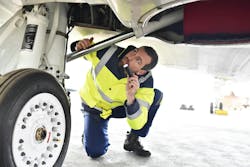4 Tips for Maintaining Hydraulic System Safety
Machines powered by hydraulic components and systems can be found in a range of applications and industries from construction to manufacturing and even amusement parks. However, care is required when working with these machines because of the high pressures at which hydraulic systems operate.
Martyn Smart, Group GHSE Manager at Pirtek, has outlined the four key tips and strategies that can be followed to ensure safe use and maintenance of hydraulic-powered machines.
1. Routine Inspections and Maintenance
Despite the durable design of hydraulic hoses and other components, the extreme pressures they endure on a repeated basis can cause damage and degradation over their lifetime. If not monitored on a routine basis, downtime and safety issues can occur.
Following a consistent maintenance schedule or employing preventative maintenance practices can help avoid these issues.
According to Smart, some may opt for easy fixes such as ‘re-ending’ where the last few inches of a hose are cut off and replaced with new fittings to extend their lifespan. However, this does not truly fix the problem and could lead to further issues down the line.
Instead, working with someone – either in house or an outside supplier – who is trained in maintaining hydraulic components and systems will ensure potential failings are properly identified and fixed to mitigate larger problems from occurring.
READ MORE: A Guide to Recognizing the Causes of Hose Failure
2. Train Technicians to Industry Standards
Hydraulic systems are known to be complex, requiring a wealth of knowledge to understand how they work and can be maintained. As such, companies with hydraulic technician teams should do their best to have personnel properly trained and certified to work with hydraulic systems.
Helping technicians stay up to date on the latest technologies and standards will help to ensure they can safely and accurately address any potential maintenance issues.
3. Provide Workers with Physical and Mental Wellbeing Programs
Smart states that working with hydraulic-powered machines and the hydraulic fluid which runs through them can be a challenging occupation due to the high temperatures and pressures of the fluids as well as often confined spaces in which it is necessary to work when replacing components.
He also notes that many hydraulic technicians work alone. This and the safety concerns associated with the job can impact personnel’s physical and mental wellbeing.
Supporting these workers on a physical and emotional level not only benefits their overall health and safety but that of the workplace as well. When they are feeling well, they are able to perform their job accurately, which leads to a safe work environment for others as well.
4. Seek Out Support from Hydraulic Industry Specialists
For those who may not have on-site technicians for their hydraulic machines or need additional support, it is always a good idea to seek out specialists with knowledge and expertise of hydraulic components and systems.
Doing so helps to ensure proper monitoring and maintenance is performed on hydraulic systems, and thus safety is maintained in the workplace. And with the ongoing skills shortage challenging many industries, including those served by hydraulics, it will likely become even more important to know which industry specialists to reach out to for help with maintaining hydraulic systems.
READ MORE: Sensors Improve Monitoring of Hydraulic Oil Conditions
About the Author
Sara Jensen
Executive Editor, Power & Motion
Sara Jensen is executive editor of Power & Motion, directing expanded coverage into the modern fluid power space, as well as mechatronic and smart technologies. She has over 15 years of publishing experience. Prior to Power & Motion she spent 11 years with a trade publication for engineers of heavy-duty equipment, the last 3 of which were as the editor and brand lead. Over the course of her time in the B2B industry, Sara has gained an extensive knowledge of various heavy-duty equipment industries — including construction, agriculture, mining and on-road trucks —along with the systems and market trends which impact them such as fluid power and electronic motion control technologies.
You can follow Sara and Power & Motion via the following social media handles:
X (formerly Twitter): @TechnlgyEditor and @PowerMotionTech
LinkedIn: @SaraJensen and @Power&Motion
Facebook: @PowerMotionTech

Leaders relevant to this article:



